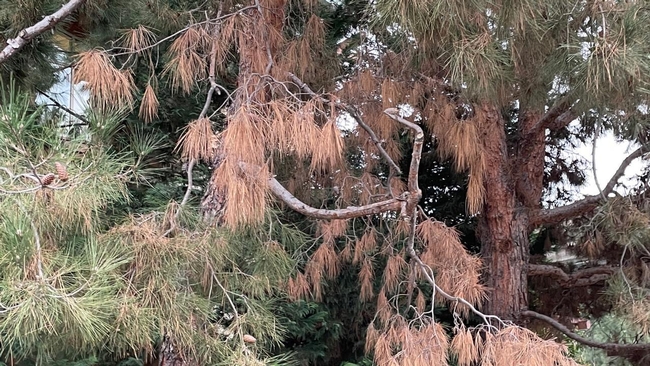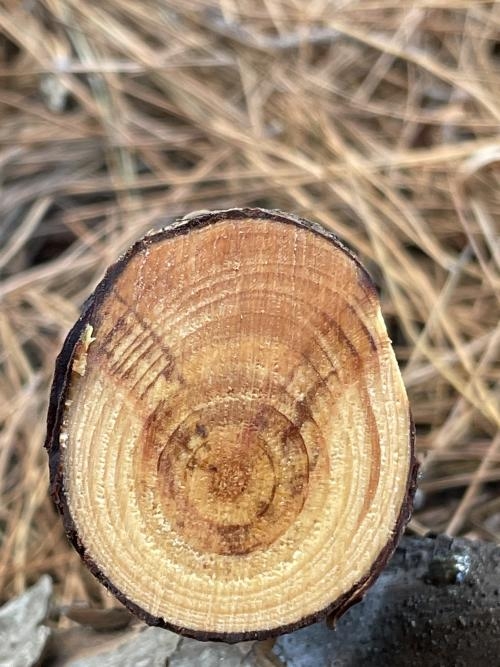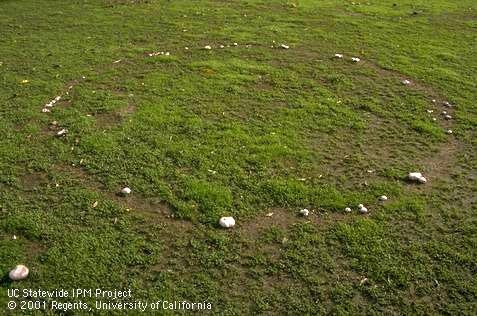Posts Tagged: Fungus
Fungi that causes pine ghost canker detected in Southern California trees
Pathogen native to U.S. but had not infected pines until recently
Fungal pathogens that cause die-back in grape, avocado, citrus, nut and other crops has found a new host and is infecting conifer trees causing pine ghost canker in urban forest areas of Southern California.
The canker can be deadly to trees.
Scientists from University of California, Davis, first spotted evidence that the pathogens had moved to pines during a routine examination of trees in Orange County. Over four years, they found that more than 30 mature pines had been infected in an area of nearly 100 acres, according to a report in the journal Plant Disease.
Akif Eskalen, a professor of Cooperative Extension in the Department of Plant Pathology at UC Davis, suspects drought and other stress conditions brought on by climate change weakened the tree species, making it more susceptible to new threats.
“We have been seeing this on pine trees for the last several years,” he said. “Our common crop pathogens are finding new hosts.”
Pine ghost canker – caused by the fungal pathogens Neofusicoccum mediterraneum and Neofusicoccum parvum – usually infects the lower part of a tree's canopy, killing branches before moving on to the trunks. This dieback in some cases can be deadly.
Points of entry
The pathogens infect a tree by entering through wounds caused by either insects such as red-haired pine bark beetles or pruning – meaning trees in managed or landscaped areas could be at risk. Another route is via tiny natural openings known as lenticels that fungi can make their way through, said Marcelo Bustamante, a Ph.D. candidate in Eskalen's lab who is first author on the paper.
Spores from the fungi can disperse and the higher the prevalence means an increased chance of transmission. Rain, irrigation water and humidity by fog can trigger the right circumstances for the spores to spread, he said.
“The detection of these pathogens in urban forests raises concerns of potential spillover events to other forest and agricultural hosts in Southern California,” Bustamante and others wrote in the report.
Dead branches can indicate a canker. Detecting the fungi is not an emergency but “people should keep an eye on their plants when they see abnormalities,” Eskalen said.
Cankers are localized areas on stems, branches and tree trunks that are usually dead, discolored and sunken. On bark, the spores can look like strings of discolored dots.
The lab has posted a brochure bout how to best manage wood canker diseases.
Tips include:
* Keep your trees healthy: Proper irrigation and maintenance will keep trees strong.
* Prune dead branches to reduce sources of infestation.
* Avoid unnecessary pruning; perform structural pruning only.
Karina Elfar, Molly Arreguin, Carissa Chiang, Samuel Wells and Karen Alarcon from the Department of Plant Pathology contributed to the paper, as did experts from Disneyland Resort Horticulture Department, State University of New York's College of Environmental Science and Forestry, UC Irvine and UC Los Angeles.
Oh the weather outside is fungal - It’s like a mushroom jungle
Mushrooms are popping up all over California thanks to the wet rainy weather we have had across the state recently. They seem to magically appear overnight, like umbrellas on a sunny beach day. This fascinating occurrence doesn't actually happen overnight as it may seem, but they appear once moisture becomes available. Mushrooms expand rapidly by absorbing water from the surrounding soil and consequently ‘pop' out of the ground.
Mushrooms are the fruiting body of a fungus and come in myriad shapes, sizes and colors. They are typically the only part of a fungus that can be seen because the mass of the organism is located underground.
There are approximately 14,000 different classified species of mushrooms, here are a few of my favorites:
The next time you see mushrooms, consider what might be happening underground in your soil. For more information on mushrooms including identification and management, visit UC IPM online.
Enjoy the wet weather and the next time you find yourself excited over a new fungal find, here is a jingle to celebrate the season:
Let it Rain (sung to the tune of ‘Let it Snow')
by Ann King Filmer
Oh the weather outside is fungal
It's like a mushroom jungle
But since we've got much to gain
Let it rain! Let it rain! Let it rain!
Scientists perplexed by verticillium wilt in lettuce
UC scientists in the Salinas Valley are trying to figure out why certain varieties of lettuce became susceptible in the 1990s to the fungus that causes verticillium wilt and how the fungus is getting into the soil.
"This is one of the more important diseases facing growers in the county," the Salinas Californian quoted UC Cooperative Extension farm advisor Steve Koike. "It has a significant impact and is increasing each year."
Strawberry crops have long suffered from the disease, but lettuce was immune. Strawberry fields are often fumigated to kill fungi, other soil-borne pests and weed seeds, however, the value of the lettuce crop doesn't justify fumigation and methyl bromide, the primary fumigant, is being phased out.
Lettuce farmers must look for other ways to manage fungus-contaminated fields, Koike told reporter Melissae Fellet. Growers can plant crops immune to the fungus, such as broccoli, cauliflower or celery, or they can plant fungus-resistant lettuce varieties.
The scientists, initially mystified about the source of the fungus, recently discovered that spinach seeds from Denmark, Holland, New Zealand and Washington state have been carrying the fungus into Salinas Valley fields, where it persists in the soil for years.
USDA awarded the researchers a $1.5 million grant to investigate how the fungus is transferred from the seeds to lettuce. UC Davis plant pathologist Krishna Subbarao, who is headquartered at the USDA research station in Salinas, is the principal investigator.

Lettuce with verticillium wilt.






